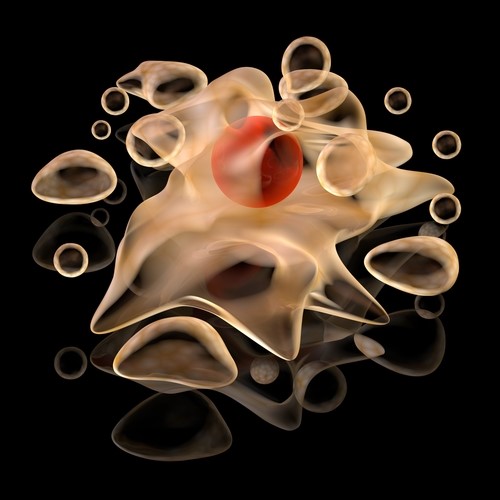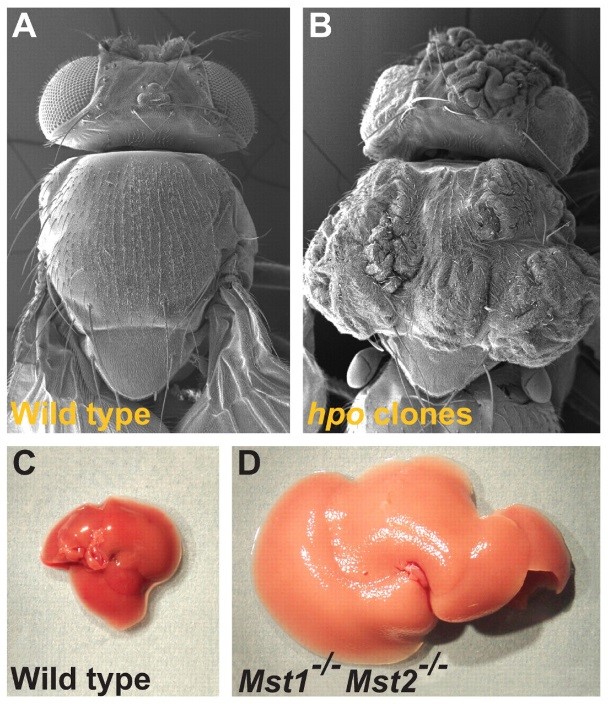Braking Mechanism Identified for Cell Growth PathwayLinked to Several Cancers
最新研究揭示Hippo信号通路反馈机制
June29, 2015 | NovoPro Biosciences

Researchersat University of California, San Diego School of Medicine have discovered aself-regulating loop in the Hippopathway, a signaling channel garnering increased attention from cancerresearchers due to its role in controlling organ size, cell proliferation andcell death.
最近,来自UCSD(University of California, SanDiego)科研人员发现了Hippo信号通路的一种自我调控的途径,这一途径在控制器官大小,细胞增殖和细胞凋亡过程中可能起着举足轻重的作用。
The finding, published June 26 online in the journal Genes & Development, provides new insights abouthow the Hippo pathway maintains cellular balance, asubject of growing interest since its malfunction can lead to uncontrolled cellgrowth and inhibition of cell death – two hallmarks of cancer.
这一发现发表在6月26日的Genes & Development上面,为Hippo信号通路如何维持细胞平衡提供了全新的视角,而细胞平衡的故障往往会引起两大典型的癌症现象:细胞无限增殖和抑制正常的细胞死亡。
“Sincecancer has been associated with overgrowth of cells, dysfunctions in thispathway are being explored in several types of tumors,” said Kun-Liang Guan, PhD, professor ofpharmacology at UC San Diego School of Medicine and Moores Cancer Center and seniorauthor of the study. Thus far, Guan said the clearest connections have beenestablished in mesothelioma, a type of cancer developed in the protectivelining that covers many internal organs of the body, and uveal melanoma, acancer in the eye – a finding published by Guan’s lab in 2014. The Hippo pathway’s involvement is also suspected in othercancers.
USCD的Kun-Liang Guan 教授解释到:“由于癌症与细胞过度增殖息息相关,Hippo信号途径的失衡将直接导致多种癌症”。目前,Guan 教授表示目前最与Hippo途径联系最清晰的癌症是间皮瘤—多数位在胸膜或腹膜和器官相接之面上;同时还有葡萄膜黑色素瘤,发病在眼睛上(2014年Guan实验室已经发票相关文章)。Hippo 信号通路目前还怀疑与其他很多癌症的发生相关。
Guan says the Hippopathway exists in most body tissues and organs, where it controls the size oforgans and tissues by keeping cell growth in check and promoting cell death asneeded. For instance, signals transmitted through the Hippo pathway tell theheart to stop growing once it has reached appropriate size. The pathway wasfirst discovered by researchers working in fruit flies in the 1990s. Theresearchers observed that, when the pathway was removed, the fruit fly grew alarge head with skin folds around the neck, reminiscent of a hippopotamus.
Hippo信号通路存在于身体大部分的组织和器官。通过促进细胞增殖以及启动细胞死亡程序来有效地控制器官和组织的大小。比如说:心脏一旦生长到了合适的尺寸就通过Hippo通路传递信号来停止发育。Hippo途径最早是90年代在果蝇的研究中发现的。当时科研人员发现了一个有趣的现象:当这条信号通路被移除是,果蝇会长出一个巨大的脑袋,脖子上也有褶皱的皮肤,看起来像河马一样。

While researchers foundthe pathway interesting from a mechanistic approach, it has only been in recentyears that its role and therapeutic potential in cancer began to be explored,said Guan. “A lot of biological pathways have been studied in cancer, but thisone is relatively new,” he said. “It gained momentum around 2005 when peoplerealized it was also present in the mammalian system. This meant that it’simportant not only in basic biology, but also in disease pathology
虽然科学家一直对Hippo信号通路的机理很感兴趣,但直到最近几年它在癌症治疗中的潜力才慢慢为人所重视。Guan继续说:“非常多的癌症信号通路都被细致的研究者,但Hippo可能是相对最新的一个了。它2005年才被人们意识到这条通路也有可能存在于哺乳动物中,这使得它不仅仅在基础生物学的研究有意义,同时也将帮助病理学方面的研究。
Guan’s lab and others havepreviously established the key signaling components of the pathway, but its controlor braking mechanism – how the pathway shuts off at the proper time – had notbeen identified until now. “It was already known that YAP and TAZ, twotranscription co-activators, work in the Hippo pathway to promote cell growthby inducing certain genes to express,” said Guan. In this study, Guan and histeam discovered that the two co-activators also have a built-in self-controlmechanism that keeps cell growth from getting out of hand. “They have anegative feedback regulation loop that puts the brakes on cell growth.”
Guan教授实验室和其他同行之前揭示了许多Hippo信号通路的核心分子,但是其调控,或者说其开关机理—怎么样在合适的时候关闭—依然不为人所了解。“目前我们知道YAP和YAZ,两个联合转录激活因子,在Hippo途径中可以通过诱导基因表达来促进细胞增殖。在这次最新的研究中,Guan教授和他的团队发现了YAP和YAZ本身也有内在的自我调控机制来保持细胞在合理的范围内增殖。“他们有一种负反馈机制,像一个调控环一样,一旦细胞过度增长就会立马刹车。

Specifically, theresearchers found that, in addition to promoting genes for cell growth, YAP andTAZ also induce expression of inhibitor genes, such as NF2, that dampen thecell growth signal. “This is important because without this brakingmechanism you would get uncontrolled cell growth, which can lead to cancer,”Guan said.
具体而言,研究人员发现,YAP和YAZ除了帮助促细胞生长的基因表达,他们也同时诱导细胞生长抑制基因,像NF2。Guan教授指出:“能抑制细胞生长非常重要,因为要不然的话,细胞失控的增长就会导致癌症”。
The findings, which weremade in both cultured cells and mouse tissues, are in keeping with previousstudies showing that knocking out the NF2 gene in mice produces uncontrolledcell growth. “Several biotech and pharmaceutical companies are looking attargeting the Hippo pathway for cancer therapy,” he said.
这个重要的发现,在体外培养的而细胞和老鼠组织内都得到证明。同时之前的研究也发现了NF2基因敲除小鼠细胞无序增长的现象。Guan教授继续谈到:”现在很多生物公司和药厂已经开始寻找Hippo信号通路的靶标用于癌症治疗”.
Guan said their findingprovides “a better picture of how these pathways keep balance, which isimportant to avoid unchecked signaling that could lead to disease.”
Guan教授最后谈到:“这个研究进一步向人们展示了生物的平衡之美,生物体会尽可能的排除掉不正确的信号传递,否则就有可能会引起疾病。
该文章的合作作者还有:Toshiro Moroishi, Hyun Woo Park,Zhipeng Meng, Steven W. Plouffe, Koji Taniguchi, and Michael Karin, UCSD;Baodong Qin, UCSD and Second Military Medical University, Shanghai, China; QianChen and Duojia Pan, Johns Hopkins University; and Fa-Xing Yu, FudanUniversity, Shanghai, China.
Englishversion modified from: ScienceBlog.com
相关文章:Genes Dev. 2015 Jun15;29(12):1271-84. doi: 10.1101/gad.262816.115.







